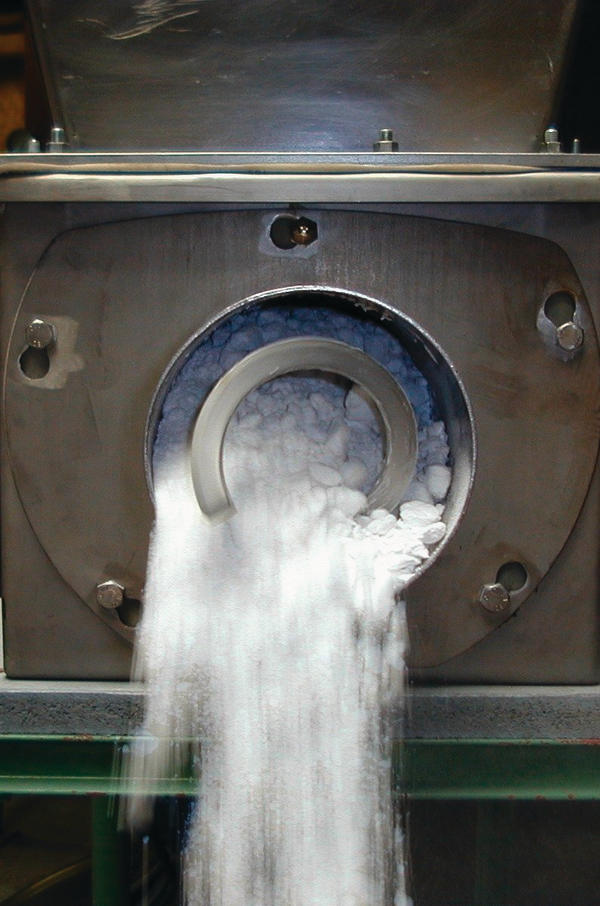There are various methods of separating solids from a suspension. These include filtration, centrifuging and drying. In most cases, further processing of the resulting products cannot be carried out directly. They have to be reduced to the right particle size by means of a mill. This can be done with a Gericke Nibbler, which shreds the filter cakes efficiently using a basket and screen assembly.
Markus H. Gericke
One of the most common ways to separate solids from a suspension is to use filter presses. The slurry is pumped into the press. The solid particles are then deposited on the filter medium and form a filter cake when pressed. This results in a residual moisture level of 15 to 50 %. The compressed filter cakes are up to 1 m² in size, several centimetres thick and of varying consistency. They can be lumpy, cloddy or smeary and are not suitable for further processing until reduced to the correct particle size, surface finish and flowability.
Gericke recently supplied a shredding device for this purpose to a chemical plant. The central component of the shredding system is a Nibbler. It consists of a rotor with horizontally arranged paddles and a U-shaped screening plate. The paddles press the filter cake through the plate, where it is shredded. The advantage of using a screening plate as opposed to hole plates is that the filter cake is cut up without producing many fine particles. In addition to this, the size of the particles does not vary significantly. The rotor of the Nibbler operates at a low rotary speed. The idea is to achieve a tip velocity of 1 to 3 m/s. This way, the products are shredded gently. Numerous products are thixotropic, which means that their viscosity decreases under shear load and the product can no longer be processed. The Nibbler provides an optimum solution to this problem with its low rotary speed and serrated screen.
The holes of the available screening plates vary in size between 1.5 and 25 mm. If a product with a higher residual moisture level needs to be shredded, it is advisable to use a hole size of at least 10 mm in order to avoid clogging. For applications with a tendency to agglomerate or be greasy, Gericke uses a mesh sieve to prevent blockage. The slight vibration in operation further supports this. The distance between the paddles and the screen is decisive for efficient operation, both in the case of the basket and of the sieve. It depends on the properties of the product to be processed.
Atex compliant
The filter cake is continuously fed from the filter press into the Nibbler via a collecting hopper. The shredded filter cake has an even granulate, lump or grain size. In the case of large filter presses, the Nibbler can be mounted on a movable frame that moves over the complete length of the filter press to process the filter cakes. In smaller units, the milled filtrate is metered and stored in drums or containers.
In very large filter presses, the transportation of the milled product can be automated by installing a conveyor belt under the Nibbler to feed the filtrate to a silo.
The Atex guidelines have resulted in a new evaluation of danger potential in the chemical industry when processing bulk products. If a shredder and a mill are used, an ignitable mixture can easily form – depending on the product to be shredded – so that the machines have to be approved accordingly. Exact explosion properties of the raw materials involved are essential for the risk analysis process. External ignition sources (e.g. metals) must be kept away from the Nibbler and suitable protection measures taken.
Various designs
Gericke Nibblers are suitable for the reduction of agglomerates and lumps after storage or drying processes and for recycling rejected products. Installed upstream of a conveying system, the Nibbler enables uninterrupted and regular transport of bulk products through the piping. The GCN (Gericke Cone Nibbler) is suitable for target particle sizes between 2 mm and 150 µm. This device grinds or granulates the particles in a conical perforated plate with a vertical rotor and paddles. Customers who are still uncertain about the optimum size and setting of the correct reduction device can carry out trials on any Nibbler model in the Gericke Test Centre or loan a machine for a limited period.
Hall 5.0, Booth D2
Online-Info www.cpp-net.com/2209435
Share:







